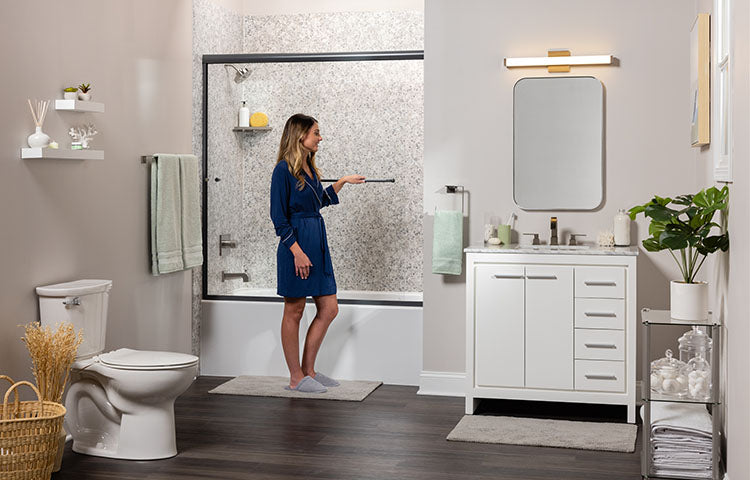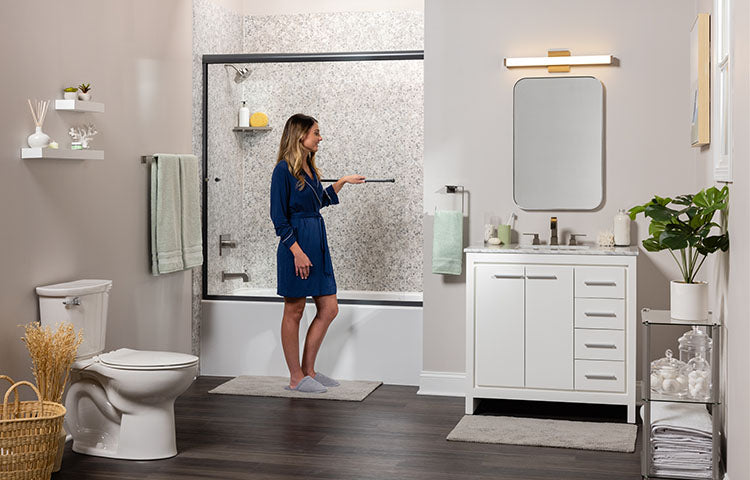After a long and stressful day, one of the best ways to wind down and relax is to soak in a hot bath. On the other hand, taking a bath might be a far less pleasurable experience if your bathtub is dirty or showing signs of deterioration. Your bathroom may look old-fashioned and unpleasant if it has a tub damaged in any way, such as being chipped, scraped, rusted, or worn. However, before you go and get rid of that old tub, you might want to think about refinishing the one you already have.
Refinishing a bathtub will save you the time and effort that would be required for a more extensive bathroom renovation job, and it will usually be more cost-effective than replacing it with something new. In addition, it allows you to keep an older design, such as an antique clawfoot tub, that gives a bathroom personality but has seen better days. This is a significant advantage. You may learn everything you need to know about refinishing a bathtub by reading the advice we have provided below.
The Typical Investment Required to Resurface a Bathtub
It is not usually straightforward to upgrade an older bathtub to a model from more recent years. In order for the original tub to be moved through the bathroom door, it nearly usually needs to be chopped up into pieces. Additionally, it is possible that the flooring, trim, surrounds, and plumbing will need to be removed and replaced at some point. Although a new tub may be purchased for as low as $150, the labor costs associated with its replacement can easily add $1,500 or more to the total cost.
Many homeowners opt to have their current tubs reglazed or refinished instead, which can range in price anywhere from $300 to $600 depending on the region and the method used. If your bathtub is discolored and soiled, or even if it has significant corrosion and fractures, a qualified specialist can likely repair and recoat the surface so that it appears as though it were brand new.
Process of Refinishing Bathtubs Done by Professionals
Tubs and shower stalls made of cast iron, steel, or fiberglass can all be recoated to have a finish identical to the original or to have an altogether different color. There are three stages that are mainly involved in the process of refinishing a bathtub:
To begin, the technician will remove the previous finish off the tub and then sand it down to create a smooth surface.
Next, any holes, cracks, chips, or rust areas are fixed.
At the end of the process, a primer, several layers of coating, and a sealer are applied. In most cases, the tub can be used again within one to three days, and the finish ought to last between ten and fifteen years.
Before refinishing a bathtub, check to see that the space has adequate ventilation. This is very important. Turn on the exhaust fan in the vent and open all of the windows and doors in the bathroom to help air out the space. After putting on protective eyewear and gloves, proceed with the following procedures to refinish your bathtub using do-it-yourself methods:
Use a heavy-duty patching compound, which can be purchased for $6.78 at The Home Depot, to repair any chips or cracks. Wait until the product has reached its full maturity before proceeding.
Take out any and all metal drains, faucets, and fixtures when necessary.
Use a mix of bleach and water to thoroughly clean the bathtub or an abrasive cleanser such as Comet, which can be purchased for $13 at Walmart. Drain the water from the bathtub.
Remove all of the caulk, then dry the area thoroughly.
Sand the bathtub to create a rough surface, aiding the coating's ability to adhere. Clean the bathtub with water to get rid of the dust.
Use a towel to dry off the bathtub. After the surface has been allowed to dry thoroughly, a dry tack cloth should be used to wipe down the tub in order to eliminate any residual dust.
Place a drop cloth on the ground and then tape off the area around the tub and any hardware still present.
After ensuring adequate ventilation, you should next proceed to apply the paint per the directions provided by the manufacturer. For the larger sections, apply the paint with a high-quality, short-nap roller that costs $6 at The Home Depot. Use a little foam brush for the corners and other areas that are difficult to access.
Apply additional coats as necessary, allowing sufficient time for drying in between each coat application.
After the coating has had sufficient time to dry, you can remove the tape, reinstall the hardware, and caulk the tub.
Before you use your bathtub, be sure the coating has had plenty of time to fully cure.
After completing a do-it-yourself bathtub refinishing project, the best way to protect the surface is to refrain from utilizing cleansers that contain abrasives.
When Is It a Good Investment to Refinish a Bathtub?
Refinishing works particularly well on really old tubs because these tubs often have more personality and are composed of higher-quality materials than those that are currently on the market. Of course, the procedure isn't always the optimal choice in every situation. For instance, if you have a recent tub that is of poor quality, you will normally obtain better results if you replace it with a model that is of greater quality. It's possible that reglazing won't work on bathtubs that are in a poor state of disrepair. In addition, if you are remodeling and want a bathtub that is larger or has more contemporary amenities, such as jets, you will need to destroy the existing bathtub and replace it with a new one rather than refinish the existing one.
At Refinished Bathtub Solutions, we provide the most effective refinishing kits on the market, which are not only offered at an affordable price but are also manufactured using the most effective solution. Made in the USA, safe for the environment, and non-toxic: The fume-free and oil-free glaze from Ekopel lasts a long time and never peels; it is also created without any dangerous ingredients. Its substantial, full-seal coating brings tub surfaces back to their original "like new" dazzling sheen.


